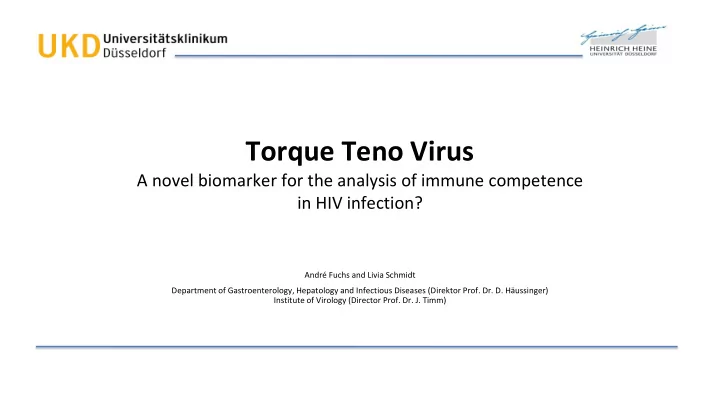

Torque Teno Virus A novel biomarker for the analysis of immune competence in HIV infection? André Fuchs and Livia Schmidt Department of Gastroenterology, Hepatology and Infectious Diseases (Direktor Prof. Dr. D. Häussinger) Institute of Virology (Director Prof. Dr. J. Timm)
Professor Andrea de Luca † 4 Feb 2019 www.who.int/hiv
Torque Teno Virus Formerly known as "Transfusion Transmitted Virus"; first • description 1997 Single stranded, uncoated DNA virus • Group of anelloviruses that make up a large proportion of the • human virome No clinical manifestations known in humans • High prevalence in the normal population with infection rates • of >90%; infection shortly after birth The (healthy) human immune system holds back virus • replication but is not able to suppress the virus permanently www.lickr.com TTV plasma concentration increases with age (senescence of • the immune system) https://viralzone.expasy.org/772
TTV as a marker of immune function Suggested as a marker for immune function: Patients with immunosuppression after solid organ – transplantation (e.g. lung, kidney, liver) (Görzer et al., 2015; Schiemann et al., 2017; Kazemi et al., 2015) In patients after allogeneic haematopoietic stem cell – transplantation (Gilles et al., 2017; Albert et al., 2018) Helpful in assessing the risk of opportunistic infections and organ rejection due to formation of antibodies
TTV as a marker of immune function Suggested as a marker for immune function: TTV and HIV-Infection: (Shibayama et al., 2001; García-Álvarez et al., 2012) Patients with immunosuppression after solid organ – HIV-infected patients: transplantation (e.g. lung, kidney, liver) (Görzer et al., 2015; Schiemann et al., 2017; Kazemi et al., 2015) − On average, have a higher plasma concentration In patients after allogeneic haematopoietic stem cell – of TTV transplantation (Gilles et al., 2017; Albert et al., 2018) − Plasma concentration of TTV and CD4 cell count Helpful in assessing the risk of are inversely correlated opportunistic infections and organ rejection due to formation of antibodies
HIV and immunodeficiency Decrease in CD4 cell count and progressive immunodeficiency during chronic HIV infection Increasing probability of opportunistic infections and other AIDS-defining diseases But: - Progress of CD4 cell loss and speed of immune reconstitution after initiation of ART individually different - Patienten Patients with AIDS-defining diseases without significantly limited CD4 cell count (> 200/µl) - So-called elite controllers - Immune Reconstitution Inflammatory Syndrome (IRIS) Thomas Splettstoesser, www.scistyle.com
HIV and immunodeficiency Decrease in CD4 cell count and progressive immunodeficiency during chronic HIV infection Increasing probability of opportunistic infections and other AIDS-defining diseases But: - Progress of CD4 cell loss and speed of immune reconstitution after initiation of ART individually different - Patienten Patients with AIDS-defining diseases without significantly limited CD4 cell count (> 200/µl) - So-called elite controllers - Immune Reconstitution Inflammatory Syndrome (IRIS) Thomas Splettstoesser, www.scistyle.com
TTV as biomarker in HIV infection The plasma TTV DNA values in HIV-1 infected patients correlate with the risk of AIDS events and predict the degree of immune regeneration after initiation of antiretroviral therapy.
TTV as biomarker in HIV infection The plasma TTV DNA values in HIV-1 infected Evaluation of TTV as a functional patients correlate with the risk of AIDS events biomarker for immune competence in and predict the degree of immune chronically HIV-infected patients regeneration after initiation of antiretroviral therapy.
TTV as biomarker in HIV infection Project 1: Correlation of TTV with HIV plasma • concentration and CD4 cell count in RESINA cohort patients Project 2: Evaluation of TTV plasma • concentration as a predictor of regeneration od immune function Project 3: Case-control study to compare • matched patients with AIDS event versus patients without AIDS event Projects in planning and preparation •
Projects in detail Project 1 Correlation of TTV with HIV plasma concentration and CD4 • Project 2 cell count in RESINA cohort patients • Project 3 • – Retrospective Analysis of TTV Plasma Concentrations in ART-naive Planned • HIV Patients projects – Analyses within two groups (CD4 > 200 /µl vs. ≤ 200 /µl) at two different time points
Projects in detail Project 1 Y-Werte Baseline Data • 1,00E+12 Project 2 TTV plasmaconcentration (cop/ml, Log) • Project 3 1,00E+10 • Planned • 1,00E+08 projects 1,00E+06 1,00E+04 1,00E+02 1,00E+00 1,00 100,00 10000,00 1000000,00 100000000,00 HIV plasmaconcentration (cop/ml, Log)
Projects in detail Project 1 Y-Werte Baseline data • 1,00E+12 Project 2 TTV plasmaconcentration (cop/ml, Log) • Project 3 1,00E+10 • Planned • 1,00E+08 projects 1,00E+06 1,00E+04 1,00E+02 1,00E+00 0,00 0,10 0,20 0,30 0,40 0,50 0,60 0,70 0,80 0,90 1,00 CD4 cell count (x10 3 /µl)
Projects in detail Project 1 Evaluation of TTV plasma concentration as a predictor of • Project 2 immune system regeneration • Project 3 • Planned • projects
Recommend
More recommend